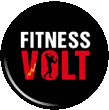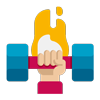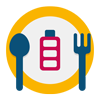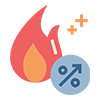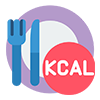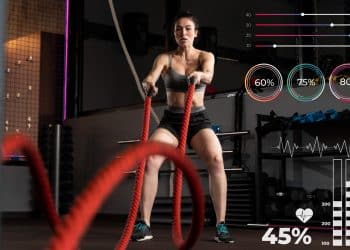The average person weighing 180 pounds burns 326 calories per hour with Gymnastics, the total calories burn depends on the your weight, intensity and type of activity.
Since gymnastics requires a great deal of strength and flexibility, you probably think doing gymnastics activities will burn a lot of calories. Continue reading to find out everything you need to know about gymnastics and how many calories you can expect to burn while practicing this intense sport.
Gymnastics is one of the most difficult sports to excel at– and for good reason. The sport combines flexibility, agility, endurance, and strength to perform acrobatic skills like jumps, flips, turns, and many other impressive stunts.
You may also be surprised to hear that gymnastics is a team sport. While you may only see a single gymnast performing in an event, gymnastics involves teams of six gymnasts who compete for both individual and team awards.
Artistic gymnastics is the most common form of gymnastics that both men and women participate in. Events of artistic gymnastics include floor routines, vaults, uneven bars, rings, the pommel horse, and horizontal bars.
The best part of gymnastics is that people of all ages and skill levels are able to participate in the sport. In fact, gymnastics activities are sometimes taught to students in primary and secondary school to promote an interest in the sport, which means people can participate in gymnastics recreationally or competitively at any age.
Level Up Your Fitness: Join our 💪 strong community in Fitness Volt Newsletter. Get daily inspiration, expert-backed workouts, nutrition tips, the latest in strength sports, and the support you need to reach your goals. Subscribe for free!
How To Use The Calculator
Using the calculator to determine how many calories you’ll burn while doing gymnastics is easy and only requires a few steps. To calculate the number of calories that you’ll burn, just input your weight and the time that you’ve spent or plan to spend doing gymnastics. Then select the gymnastics activity and hit CALCULATE.
Using the calculator step-by-step:
- Choose your unit of measurement (pounds or kilograms)
- Enter your weight in the corresponding unit of measurement
- Enter the time (in minutes) you are doing gymnastics for
- Hit CALCULATE
How the Calculator Works
Our calculator uses MET values to give you an accurate estimate of how many calories you can expect to burn while practicing gymnastics and doing other activities. The higher the MET value, the more calories you will burn.
MET (Metabolic Equivalent of Task)
MET stands for metabolic equivalent of task, and MET values allow us to give you an estimated expenditure of energy for many different activities, such as gymnastics.
A MET value is a ratio between the working metabolic rate and the resting metabolic rate [1], which is the rate of energy that is used relative to the duration of time spent doing gymnastics.
So a MET value of 1 is the equivalent of the amount of energy you expend while at rest, and a MET value of 3 means you are expending 3 times as much energy compared to being at rest.
Almost all activities that you can think of have MET values assigned to them. Some activities with MET values are common, and some are not so common. For example, there are MET values assigned to activities like hunting, standing, and even doing laundry!
Most activities come with varying levels of intensity and have different MET values assigned to them. However for this calculator, gymnastics has one level of intensity that we track with a MET value.
Formula
The formula that our gymnastics calculator uses to determine the number of calories burned per minute is (MET x bodyweight in Kg x 3.5) ÷ 200.
Examples
A person weighing 150 pounds will burn approximately 270 calories per hour from practicing gymnastics. This activity has a MET of 3.8, which means that it burns over 3 times as many calories as you do at rest.
This is what the formula for calculating the calories burned while practicing gymnastics will look like for a 150-pound individual at a MET value of 3.8.
- Calories burned (per minute) = (body weight in kg x MET x 5) ÷ 200
- Calories burned (per minute) = ( 68 x 8 x 3.5 ) ÷ 200
- Calories burned (per minute) = 5 calories x 60
- Calories burned (per hour) = 270 calories per hour
A Brief History of Gymnastics
Gymnastics traces its roots back to ancient Greece where men and women competed in gymnastics events in cities like Athens and Sparta. Since physical fitness was very desirable in men and women, the people of ancient Greece placed high importance on the early Olympic games and the gymnasts that competed in them.
As time went on in ancient Greece, gymnastics became more formalized and was used in training men for combat and as an “education of the mind”. Early forms of gymnastics emphasized discipline with a focus on strength. As the sport began to develop, gymnastics began to focus on individual gymnasts and the aesthetics involved in their performances.
Level Up Your Fitness: Join our 💪 strong community in Fitness Volt Newsletter. Get daily inspiration, expert-backed workouts, nutrition tips, the latest in strength sports, and the support you need to reach your goals. Subscribe for free!
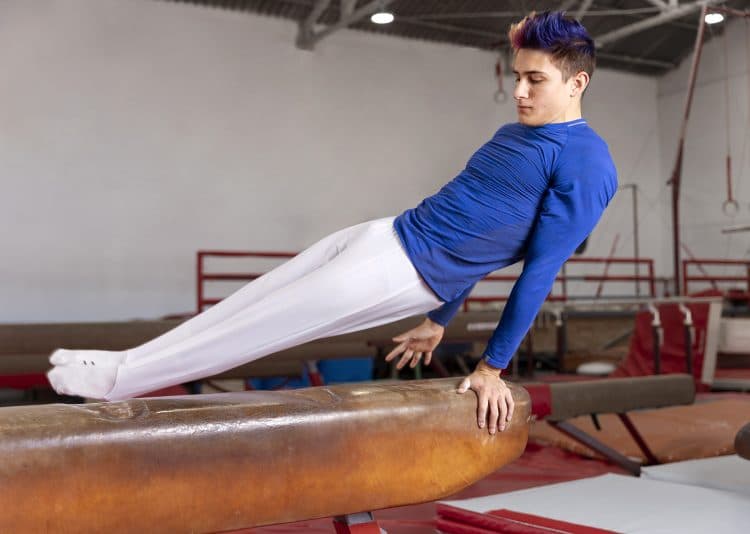
Gymnastics is the only sport that has been included in every Olympic games since 1896, and the competitiveness in gymnastics internationally has increased dramatically since it was first officially introduced at the Olympics.
Today, gymnasts come from all different walks of life and have very diverse backgrounds. However, one thing that all competitive gymnasts have in common is a great deal of flexibility, strength, and discipline to compete in some of the most difficult events at the Olympic games and in normal competition.
What Muscles Do Gymnasts Use the Most?
The specific muscles that gymnasts use depend largely on the event that they are participating in. However, most events involve a mix of upper body, lower body, and core, so it’s important for gymnasts to constantly be exercising these muscle groups to perform at the highest level.
Lower body
One movement that involves the lower body is the “back handspring”, which primarily uses your quads and glutes to produce the most power when taking off. These same muscles are used when the gymnast lands after doing flips or other common movements of gymnastics.
Flexibility is also a key component for gymnasts to be successful, so gymnasts often have extensive stretching routines before they perform in their events. Gymnasts will stretch out all muscles of the lower body, such as the calves, hamstrings, quads, glutes, and hips/
Upper body
While the back handspring uses the muscles of the lower body to generate power to lift off, the muscles of the upper body are also heavily involved in this movement and many other similar ones. The upper body is used to push off the floor when doing a back handspring as well as pushing off the vault before the gymnast takes off.
In the rings event performed by male gymnasts, they almost exclusively use their upper body to hold themselves up and perform various acrobatic movements. The pommel horse is another common event that men use their chest, triceps, and forearms to perform the activity to their best ability.
Core
Lastly, competitive gymnasts all have a very strong core, since the core is vital for stability in almost all gymnastics events. The core is constantly engaged when performing back handsprings, and routines on the uneven bars and balance beam.
Benefits of Practicing Gymnastics
Being a gymnast comes with plenty of benefits. For one, practicing gymnasts is sure to increase your flexibility due to the amount of stretching that gymnasts do as well as the need to be flexible to compete in gymnastics events.
Gymnastics is also great at improving your concentration due to the level of focus that is required to ensure that you minimize the risk of injury and perform all the moves that you need to in order to beat your competitors.
Practicing gymnastics will also allow you to improve your strength. Due to the strict training requirements of gymnastics and the need to stay in top physical shape, gymnasts find themselves frequently working out in the gym to increase their strength and become better at the events they compete in.
Equipment
There is a significant amount of equipment needed in order to participate in various gymnastics events. Examples of equipment needed for certain events include the hanging rings, balance beam, uneven bars, pommel horse, and vaults.
One benefit to practicing gymnastics is that, if you’re on a team of gymnasts or belong to a gym, most of this equipment will be provided. However, some additional equipment that you’ll need include chalk, leotards, and special gymnastics shoes.
Frequently Asked Questions:
How is muscular strength used in gymnastics?
Male gymnasts use their muscular strength when they perform different events using their body weight. The rings are one of the hardest exercises for men to perform, and to do so requires a great deal of core strength. Female gymnasts exhibit muscular strength when executing an advanced skill on the vault and other events.
Why are gymnasts so muscular?
The unfixed nature of gymnastic events means that your body has to work harder to move and perform exercises. This process recruits more muscle fibers – particularly the smaller, stabilizing muscles. Many gymnasts perform exercises using their body weight, and to do so requires you to have developed upper and lower body muscles.
What type of training do gymnasts do?
Gymnasts train for strength, power, balance, coordination, agility, and conditioning. Gymnasts must train every muscle group in order to be the best at their events. They do a combination of heavy strength training and bodyweight exercises to remain in peak physical condition.
The Bottom Line
With all the benefits that gymnastics provides, trying out the sport is a great idea that can have a positive impact on your health. People of all ages can get started doing gymnastics, and since the sport is primarily practiced indoors, you can practice gymnastics any time of year in any type of weather.
Competitive gymnasts are some of the best athletes in the world, and you can see them showcase their skills in the Olympics once every four years. It takes a great deal of strength and flexibility to be able to perform in the events that gymnasts participate in on a regular basis.
Use our gymnastics calculator to get an idea of how many calories you can expect to burn while practicing the sport, and be sure to check out all the other calculators that we have to offer at Fitness Volt!
References:
- Jetté, M., Sidney, K., & Blümchen, G. (1990). Metabolic equivalents (METS) in exercise testing, exercise prescription, and evaluation of functional capacity. Clinical cardiology, 13(8), 555–565. https://doi.org/10.1002/clc.4960130809

